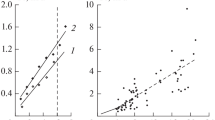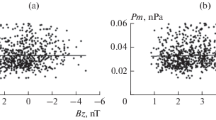Abstract
Based on the DMSP F6 and F7 satellite observations, the characteristics of precipitating particles in different auroral precipitation regions of the dayside sector have been studied depending on the solar wind plasma density. Under quiet geomagnetic conditions (|AL| < 100 nT and B z > 0), a considerable increase in the fluxes of precipitating ions is observed in the zones of structured auroral oval precipitation (AOP) and soft diffuse precipitation (SDP). A decrease in the mean energy of precipitating ions is observed simultaneously with the flux growth in these regions. The global pattern of variations in the fluxes of precipitating ions, which shows the regions of effective penetration of solar wind particles into the magnetosphere at a change in the solar wind density from 2 to 20 cm−3, has been constructed. The maximal flux variation (ΔJ i = 1.8 · 107 cm−2 s−1, i.e., 3.5% of an increase in the solar wind particle flux) is observed in the SDP region on the dayside of the Earth. The dependence of precipitating ion fluxes in the low-latitude boundary layer (LLBL), dayside polar cusp, and mantle on the solar wind density at positive and negative values of the IMF B z component has been studied. In the cusp region, an increase in the precipitating ion flux is approximately 17% of an increase in the solar wind density. The IMF southward turning does not result in an appreciable increase in the ion precipitation fluxes either in the cusp or in the mantle. This fact can indicate that the reconnection of the geomagnetic field with southward IMF is not the most effective mechanism for penetration of solar wind particles into these regions.
Similar content being viewed by others
References
M. Fujimoto, T. Mukai, H. KJawano, et al., “Geotail Observations of the Low-Latitude Boundary Layer,” Adv. Space Res. 20, 813–822 (1997).
T. A. Hviuzova and S. V. Leontyev, “Effect of Solar-Wind Density on the Intensity of Red (630.0 nm) Auroral Emission,” Geomagn. Aeron. 42(4), 519–521 (2002) [Geomagn. Aeron. 42, 492–494 (2002)].
K. Liou, P. T. Newell, C.-I. Meng, et al., “Characteristics of the Solar Wind Controlled Auroral Emissions,” J. Geophys. Res. 103, 17543–17557 (1998).
P. T. Newell, S. Wing, C.-I. Meng, and V. Sigillito, “The Auroral Oval Position, Structure and Intensity of Precipitation from 1984 onward: An Automated On-Line Data Base,” J. Geophys. Res. 96, 5877–5882 (1991b).
P. T. Newell, W. Burke, C.-I. Meng, et al., “Identification and Observations of the Plasma Mantle at Low Altitude,” J. Geophys. Res. 96, 35–45 (1991a).
P. T. Newell, W. Burke, E. R. Sanchez, et al., “The Low-Latitude Boundary Layer and the Boundary Plasma Sheet at Low Altitude: Prenoon Precipitation Regions and Convection Reversal Boundary,” J. Geophys. Res. 96, 21013–21023 (1991c).
K. W. Ogilvie, R. J. Fitzereiter, and J. D. Scudder, “Observations of Electron Beams in the Low-Latitude Boundary Layer,” J. Geophys. Res. 89, 10723–10732 (1984).
H. H. Rosenbauer, D. Grunwald, G. Montgomery, et al., “Heos 2 Plasma Observations in the Distant Polar Magnetosphere: The Mantle Plasma,” J. Geophys. Res. 80, 2723–2737 (1975).
N. Sckopke, G. Pashmann, G. Haerendel, et al., “Structure of the Low-Latitude Boundary Layer,” J. Geophys. Res. 86, 2099–2110 (1981).
G. V. Starkov, B. V. Rezhenov, V. G. Vorobjev, et al., “Dayside Auroral Precipitation Structure,” Geomagn. Aeron. 42(2), 186–194 (2002) [Geomagn. Aeron. 42, 176–183 (2002)].
G. V. Starkov, B. V. Rezhenov, V. G. Vorobjev, and Ya. I. Feldstein, “Planetary Distribution of Auroral Precipitation and Its Relation to the Zones of Auroral Luminosity,” Geomagn. Aeron. 43(5), 609–619 (2002) [Geomagn. Aeron. 43, 569–578 (2003)].
T. Terasawa, M. Fujimoto, T. Mukai, et al., “Solar Wind Control of Density and Temperature in the Near-Earth Plasma Sheet WIND/GEOTAIL Collaboration,” Geophys. Res. Lett. 24, 935–938 (1997).
V. G. Vorobjev, B. V. Rezhenov, and O. I. Yagodkina, “The Solar Wind Plasma Density Control of Night-Time Auroral Particle Precipitation,” Ann. Geophys. 22, 1046–1052 (2004).
Author information
Authors and Affiliations
Additional information
Original Russian Text © V.G. Vorobjev, O.I. Yagodkina, 2006, published in Geomagnetizm i Aeronomiya, 2006, Vol. 46, No. 1, pp. 55–61.
Rights and permissions
About this article
Cite this article
Vorobjev, V.G., Yagodkina, O.I. Influence of the solar wind plasma density on the auroral precipitation characteristics. Geomagn. Aeron. 46, 52–57 (2006). https://doi.org/10.1134/S0016793206010051
Received:
Accepted:
Issue Date:
DOI: https://doi.org/10.1134/S0016793206010051




